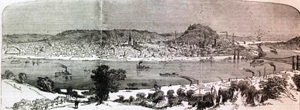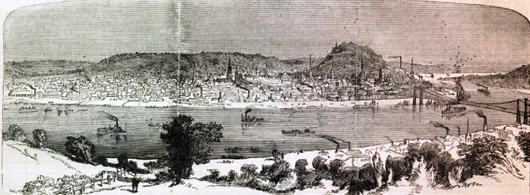
The Cincinnati Riverfront Panorama was captured by Charles Fontayne and William S. Porter as they stood on a Newport, Ky., rooftop and looked across the Ohio River, the Cincinnati Enquirer reports.
The photos go on permanent display at the Public Library of Cincinnati and Hamilton County main branch beginning with the unveiling ceremony.
“It’s a one-of-a-kind object,” said Ralph Wiegandt, conservator for the George Eastman House of International Museum of Photography and Film in Rochester, N.Y. “It boggles the mind. We’re still reveling in its magnificence.”
The library acquired the photos – the size of large postcards – in the early 20th century and they have been in storage since 1955 for protection. The Eastman House examined, cleaned and stabilized the photos in 2006 and 2007.
The Enquirer reports that photography was in its infancy in 1848 and the panorama showed that photos could not only capture images of people but also of landscapes. It’s considered the oldest surviving photo of its kind of an American city. The eight images are daguerreotypes made in a camera on a silver plate.
The exhibit will include interactive screens where viewers can zoom in on details from the photos, such as laundry on a clothesline, names on steamboats, a man sitting on a log outside a sawmill and the Second Presbyterian Church clock tower reading 1:55 p.m. – a detail unknown until the Eastman House did its work.
“We can see far more in the photos than Fontayne and Porter could when they took the pictures,” said Patricia Van Skaik, manager of the library’s genealogy and local history department.
“It enables us to understand what life was like in Cincinnati in the mid-19th century in a way that we have never been able to before.”
Fontayne and Porter worked as partners in a Cincinnati photo gallery from 1847 to 1854.
Their photos won a top award at the Franklin Institute in Philadelphia in 1849 and were displayed at the first world’s fair at London’s Crystal Palace two years later.
“It’s truly a miracle in every way,” Wiegandt said. “Everything worked. There’s nothing to compare it to.”
___
Information from: The Cincinnati Enquirer, http://www.enquirer.com
Copyright 2011 Associated Press. All rights reserved. This material may not be published, broadcast, rewritten, or redistributed.
AP-WF-05-15-11 2114GMT
ADDITIONAL IMAGE OF NOTE


